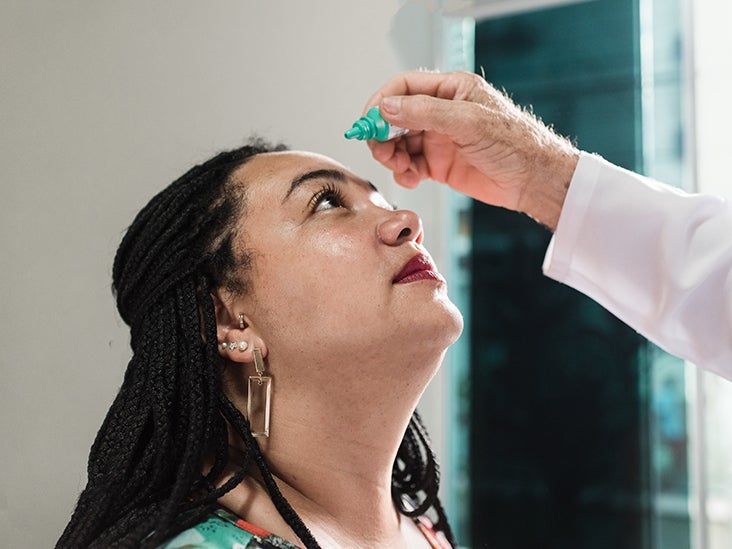
Your doctor may recommend one of several dry eye surgical procedures if other treatment options don’t work for you. While these procedures are minimally invasive, they may cause side effects.
Punctal plugs
A punctal plug is a barrier in the tear duct that partially or fully blocks your natural tears from draining away from your eyes. This helps keep your eyes moisturized.
There are two types of punctal plugs:
- Temporary punctal plugs. These are made from collagen or another material that the body dissolves and absorbs within a few days to months. A doctor may recommend this option so you can test it out or following a surgical procedure like LASIK.
- Semi-permanent plugs. These are often made from silicone or acrylic. They can last for years. A doctor can remove them later on if needed.
Both types of plugs are inserted into the puncta, which are small openings where tears naturally drain from your eyes. Semi-permanent plugs are sometimes inserted farther down, in a part of the tear duct known as the canaliculus.
Inserting punctal plugs is a noninvasive procedure. Your doctor may or may not provide local anesthesia to numb the area.
You might feel pressure as the devices are inserted. Most people can resume their normal activities immediately.
You may notice an irritated or scratchy feeling near where your doctor inserted the plugs. Most people get used to this feeling.
Other rarer issues can include:
- the plug coming out or moving around
- an improper fit, which may cause the plug to rub against your eye
- increased risk of infection
- watery eyes
- tear duct irritation
Thermal cautery
Thermal cautery is a minimally invasive surgery where your doctor uses heat to close your tear ducts and prevent moisture loss. It’s usually recommended if punctal plugs don’t work.
Your practitioner may cauterize the opening to your tear ducts permanently. Or the puncta may be cauterized superficially, so they’re easy to reopen in the future.
The area will be numbed during the procedure. It’s done in your doctor’s office and typically takes a few minutes to perform.
Avoid touching or rubbing your eyes after the procedure. Your doctor will likely prescribe antibiotics to prevent infection.
Intense pulsed light therapy
Meibomian gland dysfunction (MGD) is a common cause of dry eye disease. People with this condition produce abnormal meibum. This oily substance prevents tears from evaporating from the eyes.
A 2015 review of studies concluded that intense pulsed light (IPL) therapy may effectively treat dry eyes in people with MGD.
IPL therapy is a noninvasive procedure that’s often used to treat skin conditions such as rosacea.
Pulses of light are used to selectively destroy vascular structures in the eyelid. This can help reduce inflammation and improve how the meibomian glands function.
Before you undergo this procedure, a protective gel will be spread around your eyes and you’ll put on goggles. Your doctor will then use a device to send flashes of light into the skin surrounding your eye.
You’ll apply a special sunblock to treated areas for 48 hours after IPL therapy. You may need four separate follow-up sessions for the most effective treatment.
Laser surgery
Laser-assisted in situ keratomileusis (LASIK) surgery to correct your vision often causes temporary dry eye. It may also improve preexisting dry eye.
According to the American Refractive Surgery Council, about 60 percent of people in an FDA study who reported dry eye prior to LASIK said they noticed improvements following the procedure.
Because LASIK surgery commonly makes eyes dry while they heal, your doctor may recommend inserting temporary punctal plugs or using other dry eye treatments.
Minor gland salivary autotransplant
Severe dry eye syndrome is sometimes linked to rare disorders, such as Stevens-Johnson syndrome or ocular cicatricial mucous membrane pemphigoid.
Medications and most surgical procedures don’t correct dry eye in people with these conditions. This can eventually cause blindness.
If you have severe and otherwise untreatable dry eye, your doctor may recommend minor gland salivary autotransplant. This relatively new procedure involves implanting a salivary gland in place of your tear duct to keep your eyes moisturized.
A 2017 study found that this treatment option effectively treated dry eye. Talk with your doctor if you’d like to learn more.
Amniotic membrane
Amniotic membrane (AM) is another option for people with keratitis that isn’t manageable with other treatments. Keratitis is damage to the surface of the eye caused by dryness.
The AM protects the eye by acting as a physical barrier. It’s also thought to have antimicrobial properties.
The procedure involves implanting AM to the surface of the eye. The tissue is harvested during elective C-sections, screened for disease, and treated with antibiotics.
This technique previously involved surgery to implant the AM. A growing number of procedures these days are noninvasive, however, and are done in a doctor’s office.
There are two types of AM:
- Cryopreserved AM. Cryopreserved AM, such as ProKera (BioTissue), are preserved and stored in a freezer. The AM is secured with a ring or band and inserted into the eye similarly to a contact lens.
- Dehydrated AM. Dehydrated AM, such as AmbioDisk (IOP Ophthalmics), are dehydrated tissues that are applied to the eye in the doctor’s office, with an overlying bandage contact lens.
January 15, 2021 at 10:03PM
https://www.healthline.com/health/dry-eye/dry-eye-surgery-are-you-a-candidate
Dry Eye Surgery: Laser, Cost, and More - Healthline
https://news.google.com/search?q=dry&hl=en-US&gl=US&ceid=US:en

No comments:
Post a Comment